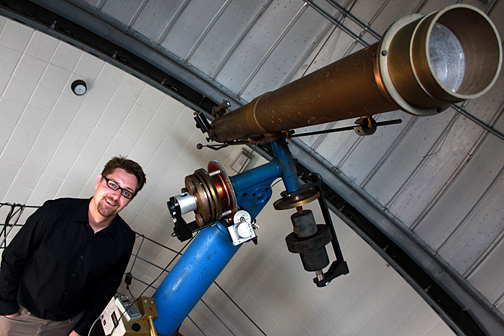There have been hotter days in Toledo this summer than in the atmosphere of a new class of stars discovered right in our galactic neighborhood by a University of Toledo researcher.

Dr. Michael Cushing, assistant professor of astronomy and director of the Ritter Planetarium, shown here in the Brooks Observatory, is part of a team that discovered a new type of star, the Y Dwarf.
“Brown dwarfs have the mass of very small stars, but never got hot enough to ignite the thermonuclear fires that keep stars like our sun shining for billions of years. Instead they’ve just gradually cooled down over time,” Cushing said.
In a statement released by NASA, Cushing told the space agency that “Finding brown dwarfs near our sun is like discovering there’s a hidden house on your block that you didn’t know about. It’s thrilling to me to know we’ve got neighbors out there yet to be discovered. With WISE [NASA’s Wide-field Infrared Survey Explorer], we may even find a brown dwarf closer to us than our closest known star.”

This NASA artist's conception illustrates what a Y dwarf might look like. Y dwarfs are the coldest star-like bodies known, with temperatures that can be even cooler than the human body.
“Because these stars are so cold, they emit almost no visible light,” he said. “By using WISE, we were able to detect what are essentially failed stars using infrared light.”
The team also used the Hubble Space Telescope to home in on candidates once WISE identified them. Cushing said they have discovered six Y dwarfs so far, all within 40 light years of Earth, but believe there could be many more out there.
“We’re looking for more Y dwarfs and we’re also looking to see if there are still colder stars out there somewhere,” he said. “Just how cold can a star get?”
So what’s in the atmosphere of a room-temperature star? According to Cushing, primarily molecular hydrogen, but also water, methane and possibly ammonia.
As part of his work at UT, Cushing also will serve as director for Ritter Planetarium, which is finalizing the installation of a new three-dimensional SciDome XD projector system. This system will use two ultra-bright digital projectors to transmit more than six million pixels onto the building’s 40-foot dome.
“We’re the first planetarium in the nation to get this new system, and we are hoping to be the first to highlight the discovery of Y dwarfs as well,” Cushing said.